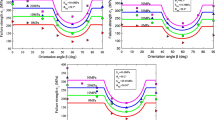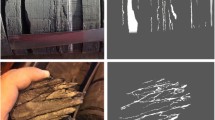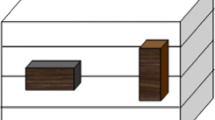Abstract
Traditional prediction methods for formation integrity collapse pressure are difficult to describe for shale microfractures, joints, and weakness planes. In this study, for multiple weakness planes, a reasonable prediction model for shale wellbore collapse instability is constructed using the Mohr–Coulomb criterion and the multistructural plane strength theory, which can analyze the wellbore collapse pressure considering different weak planes. The results show that the collapse pressure increases with the increase in the number of weak planes. With an increase in the number of weak planes, the safe drilling window becomes narrower, which leads to an increase in the drilling difficulty. With the change in the drilling azimuth, the weak plane dip region where the maximum collapse pressure is located for different weak plane groups is transformed. For a weak plane group, the maximum collapse pressure changes from a dip angle of 30°–60° to 0° and 90° with the drilling azimuth. When the dip angle of two weak plane groups is 0°, the collapse pressure of the wellbore is the lowest, and the maximum collapse pressure changes from 60°–90° to 30°–60° with the change in drilling azimuth. When drilling along the minimum horizontal ground stress azimuth, there is only a difference when the included angle of inclination is 60°–180° and 240°–360°, and the other azimuth coincide, which indicates that the influence of the weak plane inclination on the collapse pressure is weakened when drilling along the azimuth. The effect of multiple weak planes on the collapse pressure is more significant in the later stages of drilling. The example analysis shows that under the action of multiple weak planes, the method can predict the formation collapse pressure more comprehensively and accurately than previous methods, which is meaningful in guiding drilling engineering in shale formations.

















Similar content being viewed by others
References
Aadnoy BS (1991) Effects of reservoir depletion on borehole stability. J Pet Sci Eng 6(1):57–61
Aadnoy BS et al (1988) Modeling of the stability of highly inclined boreholes in anisotropic rock formations (includes associated papers 19213 and 19886). SPE Drill Eng 3(3):259–268
Cai MF, He MC, Liu DY (2002) Rock mechanics and engineering[M]. Science Press, Beijing
Chen X, Tan CP, Detournay C (2003) A study on wellbore stability in fractured rock masses with impact of mud infiltration. J Pet Sci Eng 38(3/4):145–154
Chen M, Jin Y, Zhang GQ (2008) Rock mechanic on petroleum engineering. Science Press, Beijing, pp 99–118
Chenevert ME, Gatlin C (1965) Mechanical anisotropies of laminated sedimentary rocks. SPE J 5(1):67–77
Deng H, Meng YF, Chen LP et al (2006) Study on stability of brittle shale hydration. Nat Gas Ind 26(2):73–76
Dusseault MB, Gray KE (1992) Mechanisms of stress-induced wellbore damage[C]∥paper 23825-MS presented at the SPE Formation Damage Control Symposium, 26–27 February 1992, Lafayette, Louisiana, USA. SPE, New York
Jaeger JC (1960) Shear failure of anisotropic rocks. Geol Mag 97(1):65–72
Jia LC, Lian TW, Li ZF (2017) Shale strength weakening law and its effect on the stability of horizontal well wall. Drill Prod Technol 3:45–51
Jin Y, Chen M, Chen ZX et al (1999) Mechanical model of sidewall stability of straight wells drilled through weakly consolidated formation. Drill Prod Technol 22(3):13–14
Lee H, Ong SH, Azeemuddin M et al (2012) A wellbore stability model for formations with anisotropic rock strengths. J Pet Sci Eng 96/97(19):109–119
Liang L, Huang J, Liu X et al (2014) Effect of natural fracture on formation and propagation of induced fracture around borehole in shale reservoir. Geol Sci Technol Inf 33(5):160–165
Liu X, Ye Z, Chen YJ (2002) Influence of rock weak plane texture on sidewall stability. Nat Gas Ind 22(2):41–42
Liu YF, Fu YQ, Tang G, et al. (2012) Effect of weak bedding bedding planes on wellbore stability for shale gas [R]. SPE 155666
Liu ZY, Chen M, Jin Y et al (2014) Calculation model for borehole collapse volume of a horizontal open-hole in multiple-weak-plane formation. Pet Explor Dev 41(1):102–107
Lu YH, Chen M, Jin Y et al (2012) A mechanical model of borehole stability for weak plane formation under porous flow. Pet Sci Technol 30(15):1629–1638
Lu YH, Chen M, Jin Y et al (2013) Influence of porous flow on wellbore stability for an inclined well with weak plane formation. Pet Sci Technol 31(6):616–624
Ma T, Chen P (2015) Analysis of wellbore stability for horizontal wells in stratification shale. J Central South Univ 46(4):1375–1383
Okland D, Cook JM (1998) Bedding-related borehole instability in high-angle wells. SPE/ISRM Rock Mech Pet Eng 1998:413–422
Ong SH, Roegiers JC (1996) Fracture initiation from inclined wellbores in anisotropic formations. J Petrol Technol 48(7):614–619
Qin Q, Deng H (2007) Influence of rock fractures on mechanical stability of well-wall. J Southwest Pet Univ 29(4):167–170
Wang JQ, Li GM, Zhao HB et al (2012) Stability analysis of a borehole wall during horizontal directional drilling in fluid solid coupling condition. Chin J Underground Space Eng 8(4):796–801
Xie YY, Xiao HT, Runqiang G (2017) Transversely isotropic elastoplastic model and numerical realization of layered rock mass. J Railway Sci Eng 09:65–72
Yan C, Deng J, Yu B et al (2013) Research on collapsing pressure of gas shale. Chin J Rock Mechan Eng 32(8):1595–1602
Yuan J, Deng J, Baohua YU et al (2012) Wellbore stability of horizontal wells in shale gas reservoirs. Nat Gas Ind 32(9):66–70
Zhao J, Deng J, Huang Z et al (2014) Numerical analysis of borehole instability mechanism in layered shale formation based on FLAC3D. Sci Technol Rev 32(13):46–52
Acknowledgements
This research was supported by National Natural Science Foundation of China (Grant No. 52074088, Grant No. 51574088, Grant No. 51404073), HeiLongJiang Postdoctoral Foundation (LBH-Z19008), Talented Reserves of Heilongjiang Province Science Foundation for Distinguished Young Scholars of Northeast Petroleum University (Grant No. SJQHB201802), Development of western oil fields special project (Grant No. XBYTKT202001), Talented Reserves of Heilongjiang Province Science Foundation for Distinguished Young Scholars of Northeast Petroleum University (Grant No. SJQH202002), and 2020 Heilongjiang Province Postdoctoral research project
Author information
Authors and Affiliations
Corresponding author
Ethics declarations
Conflicts of interest
The authors declare no conflicts of interest. To the best of our knowledge, the authors have no conflict of interest, financial or otherwise.
Additional information
Publisher's Note
Springer Nature remains neutral with regard to jurisdictional claims in published maps and institutional affiliations.
Rights and permissions
About this article
Cite this article
Zhao, W., Liu, Y., Wang, T. et al. Stability analysis of wellbore for multiple weakness planes in shale formations. Geomech. Geophys. Geo-energ. Geo-resour. 7, 44 (2021). https://doi.org/10.1007/s40948-021-00228-7
Received:
Accepted:
Published:
DOI: https://doi.org/10.1007/s40948-021-00228-7




